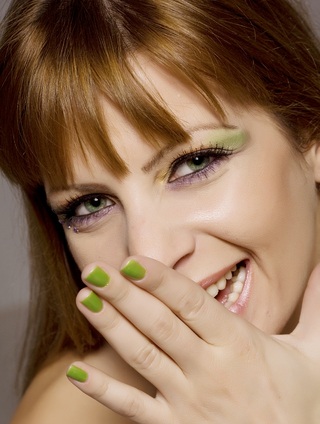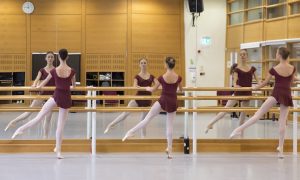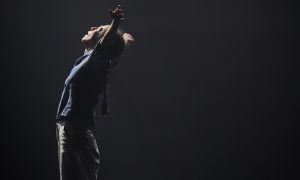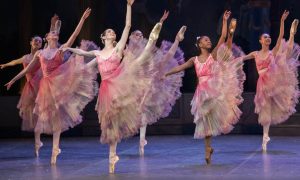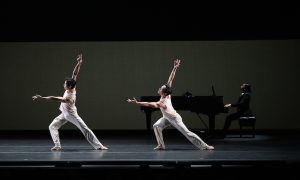By Kristy Johnson.
At Dance Informa HQ we’re going to tackle your makeup mishaps head on, with a little help from professional artists Isabella Schimid and Linda West. Isabella has a passion for makeup that extends to over 20 years of experience. Her versatility has seen her work in fashion, film, TV, editorial and advertising in Hong Kong, Los Angeles, New York and Australia. Linda is a highly successful Sydney based makeup artist and hair stylist, freelancing for television productions, commercials, editorial and advertising.
What is important for a dancer to consider when selecting a foundation or makeup base?
Isabella: Good even coverage, correct colour match to the rest of body, and oil free. If they have good skin, then a powder foundation is enough.
Linda: It’s crucial to match foundation to the skin tone on your chest area, especially if you have a fake tan. A colour that is only slightly lighter than your body colour will be most flattering.
When preparing for a photo shoot, some foundations can produce a ‘high shine’ look. What are the best products/techniques to combat or prevent this?
Isabella: Using an anti-shine product under the foundation will help prevent too much shine and help minimise sweat. Set the foundation with a good blotting powder and use blotting sheets to keep shine down.
Linda: Sometimes dewy or luminous skin can easily get confused with shine! To achieve a soft, dewy complexion, only apply powder to the tip of the nose or anywhere you see shine – usually it’s on the angles of the face where light hits. Best not to apply powder heavily over the whole face ‘just to be sure’ as your make-up will end up looking overdone. If you find that no matter how much powder you apply and you’re still seeing shine, then take a look at your products – if there is any shimmer, glimmer or sparkle in them you will always have shine. Matte powders will work best if used where needed.

Makeup Artist Isabella Schimid
Any specific techniques to add contouring or dimension to the face?
Isabella: Using powders to create contour is probably the easiest. A darker powder will absorb the light and give depth to the cheeks, temple and jaw line. Lighter reflecting powders will highlight and give height to cheekbones.
Linda: Follow the natural contours of the face; the hollows of the temple and under the cheek bone for example. Flat, matte colours work best using a darker foundation and a contour brush. My best tip for contouring would be: do not use bronzer! They are almost always shimmery and this gives a different effect to what you want to create here. To lift an area like the top of cheek bones, apply a luminous, pale highlighter with your fingers and blend.
When on a shoot or performing on stage, which makeup products or tools would you recommend having on hand?
Isabella: Anti-shine products under foundation to absorb oil and sweat, a good blotting powder and/or blotting sheets to absorb oil.
Linda: An important tip for a shoot is to always extend your foundation on to your body, particularly your chest area (obviously avoid getting it on your clothes). Extending your foundation further than your face will make such a difference to your final photo image or the TV shoot. For stage, heat or for make-up to last the distance and stop running off your face, a make-up ‘fixer’ spray such as Ben Nye’s ‘Final Seal’ will help do the trick.
What common ‘makeup mistakes’ do you see dancers make?
Isabella: Using the wrong foundation colour: either too dark or too light from your actual body colour, a heavy oily finish, or not blended in to hair and jaw line.
Linda: Too-heavy foundation coverage: it’s best applied only where it’s needed and blended out well. If you have a spot or blemish, use a concealer over foundation and not under for the best result. Glittery/shimmery bronzer used instead of foundation is not a great look especially in daylight.

Makeup Artist Linda West
How important overall is makeup in the grooming process?
Isabella: Very important, as the wrong colour foundation or a thick coverage can look unnatural and overly made-up.
Linda: It’s the icing on the cake. Even if it’s just groomed brows, curled lashes and lip tint, it completes a look.
Any runway or industry trends dancers should give a go?
Isabella: Well groomed eyebrows either darkened with a pencil or tinted professionally, is always in trend. Slightly shaped and no ‘over-plucked thin tadpole’ looking brows. If hair colour is very blonde, then having the brows slightly lightened looks amazing, especially with a smokey eye.
Linda: Bright, fluoro-like colours on lips or eyes. Many eye shadow products contain a high pigment content which is great for stage, and these can be mixed with a mixing medium for staying power. A new range from the U.K. called Illamasqua has intense colour pigments with terrific lasting power.
Makeup should compliment the clothing, persona and style of a dancer. Should there be a briefing session prior to makeup application, to determine what look will suit the dancer best?
Isabella: Yes, it’s all about the complete package. If the dancer has a soft pretty persona, then applying thick heavy eye makeup would not suit the overall look. Understanding the dancer and discussing the overall look is important to achieve the best balance.
Linda: The choreographer or creative director may have ideas on how the makeup should look to suit the piece. It’s always easiest when visual examples are given during a brief rather than always relying on verbal explanation. Any final adjustments can be altered during dress rehearsals to make sure the look compliments the lighting, staging and wardrobe. Also the venue size should be considered – does the makeup look good from the audience’s point of view whether seated in the front rows, middle or very last row?
Grooming and beauty is not just skin deep. Do you have any nutritional recommendations for a great complexion?
Isabella: Makeup always looks best on a clear complexion so it’s very important to look after the skin from the inside and out. Avoid caffeine and fatty oily foods. A well-balanced diet will assist in a clear complexion.
Linda: It goes without saying, drink plenty of water and eat a varied diet with plenty of fruit and vegetables. Zinc based foods such green veggies help with skin healing and keeping acne under control. For supple skin, eat foods containing Vitamin A such as eggs and oily fish. Vitamin C found in strawberries and peas will help collagen rejuvenation.


